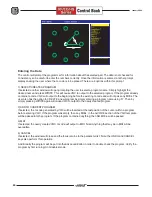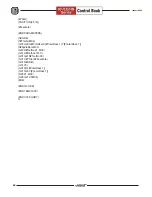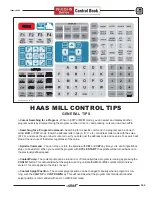
92
January 2004
S
TOPPING
A
UTOMATIC
O
PERATION
There are several ways a program can be stopped. They include both normal stops and abnormal, or alarm
caused, stops. The normal stops are:
1. Normal completion at M00, M01, M02, or M30.
2. A FEED HOLD stop by the operator. The program is continued by pressing CYCLE START again.
3. An operator selected SINGLE BLOCK stop. The program will continue by pressing CYCLE START again.
4. A Door Hold stop caused by the operator opening the enclosure doors. The program continues when the
doors are closed.
The abnormal stops are:
1.
Operator Reset
This stops all axes motion, stops the tool changer, turns off the spindle, and
turns off the coolant pump. Program operation cannot be continued from the stopping point. If
Setting 31 is
On
, the program pointer is reset to the beginning.
2.
Emergency Stop
This stops all axes motion, disables the servos, stops the tool changer, turns
off the spindle, and turns off the coolant pump. Program operation cannot be continued from the
stopping point. This will also stop any auxiliary axes motion. RESET must be used at least twice
to remove the alarms and start again.
3.
Alarm Condition
This can occur any time an alarm comes on during program operation. Since a
program cannot be restarted until RESET is pressed, a program execution cannot be continued
from the stopping point. Alarms can be caused by programming errors or machine faults. Use the
Graphics simulation mode to test your program first for errors.
4.
Power-off
This will stop all motors within one second but does not guarantee any conditions when
the machine is powered-on again.
C
REATING
P
ROGRAMS
To create a new program, you must be in the PRGRM/CONVRS display and LIST PROG mode. Enter
O
(letter,
not number) and a five-digit program number and press SELECT PROG key or ENTER. The selected program
is the Main program and is the one you will see in the MEM and EDIT modes. Press EDIT to show the new
program. A new program will begin and consist of only the
Onnnnn
and an EOB (;). All further entries are made
by typing a letter followed by a numeric value and pressing INSERT, ALTER, or WRITE. All items entered into a
program are either addressed data (a letter of the alphabet followed by a number), or a comment (text sur-
rounded by parentheses; maximum of 80 characters) or the End-of-Block command (EOB or ;).
The CURSOR
up
and
down
keys can be used to search for the entered value. Simply enter the value to
search for on the bottom line and press the CURSOR
up
or
down
keys. The CURSOR
up
key will search for
the entered item backwards to the start of the program. The CURSOR
down
key will search forward to the end
of the program. Searching also works in MEM mode. If you enter a letter without a number, the search will stop
on the first use of that letter with any value.
NOTE :
When INSERT is pressed, the new data is put in after the highlighted data. The
CURSOR
up
,
down
,
left
, and
right
keys are used to select the item to search
for. The PAGE UP and PAGE DOWN keys move farther distances and the HOME
and END keys go to the start or end of the program. All of these keys work in
EDIT, MEM, and MDI modes.
Summary of Contents for EC Series
Page 1: ...January 2004 ...
Page 7: ...V I January 2004 ...
Page 125: ...118 January 2004 ...
Page 126: ......
















































